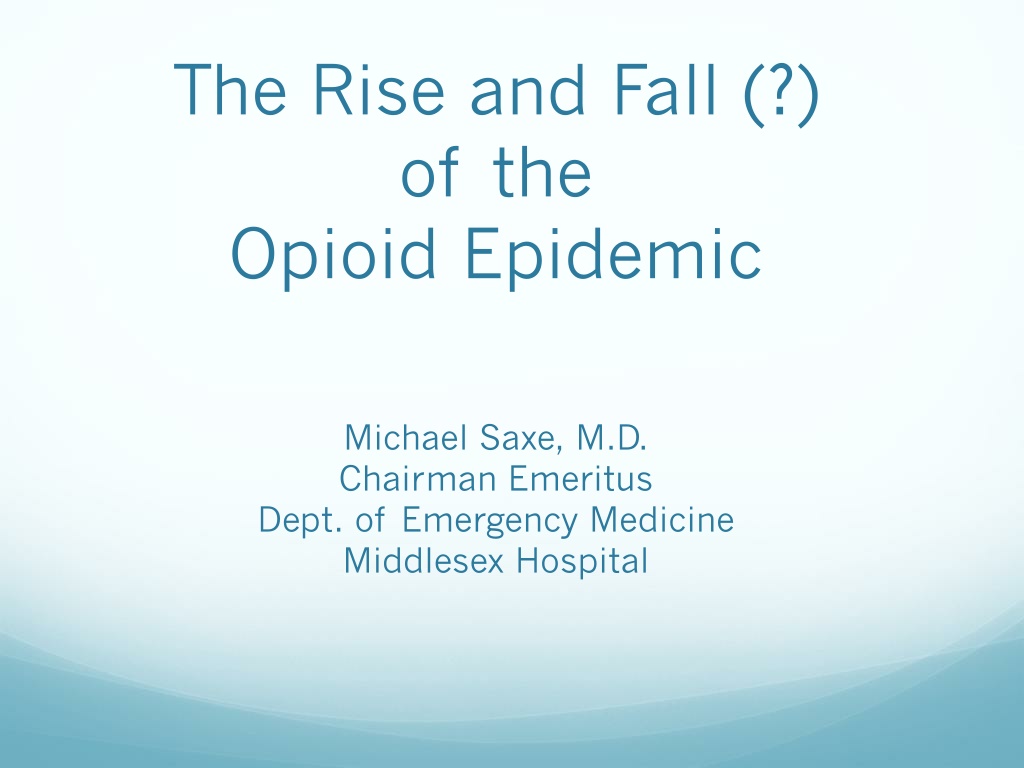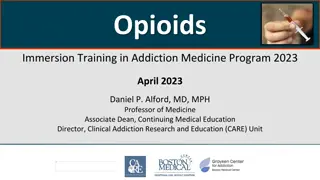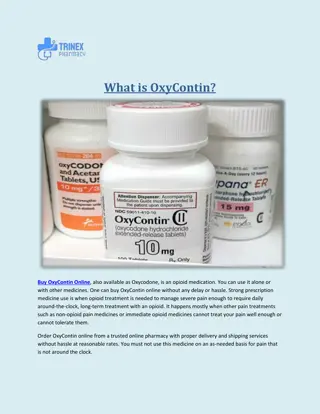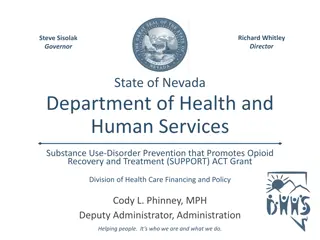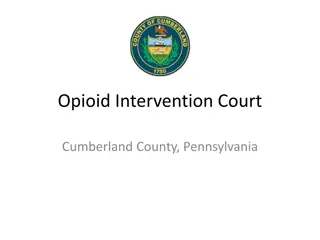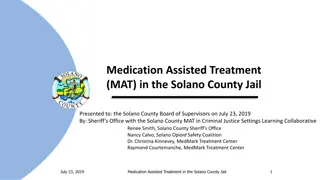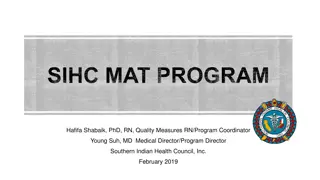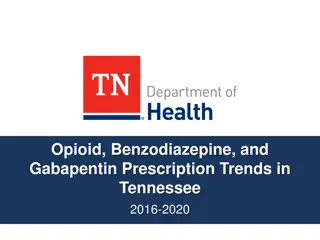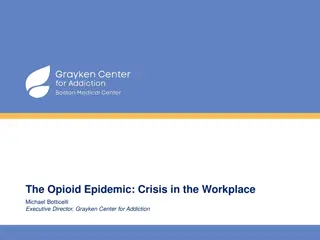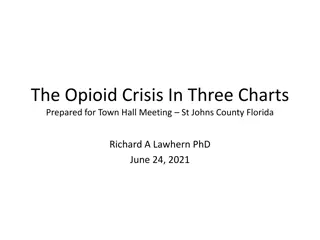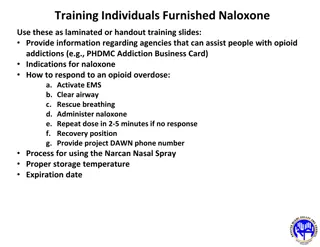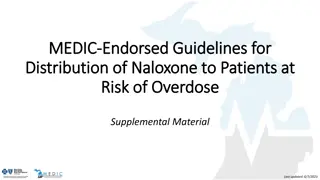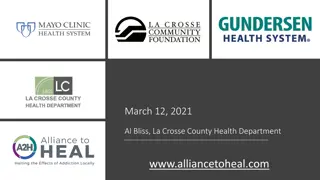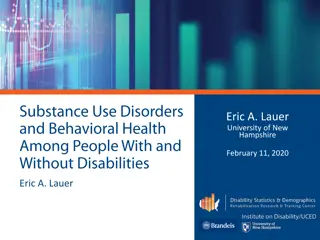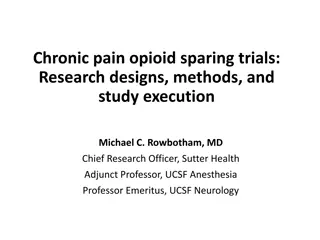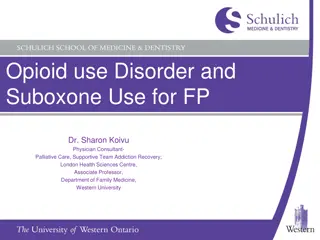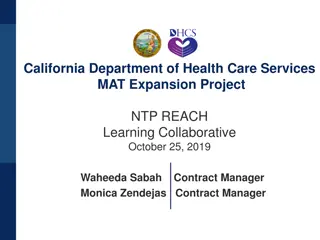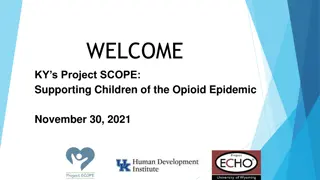The Opioid Epidemic: History, Causes, and Solutions
Explore the rise and fall of the opioid epidemic, delving into the history of opium and opioids, understanding the current crisis, and learning how prescribers and patients play a role. Discover ways you can contribute to ending this epidemic by gaining insights into the past and present effects of opioid abuse.
Download Presentation

Please find below an Image/Link to download the presentation.
The content on the website is provided AS IS for your information and personal use only. It may not be sold, licensed, or shared on other websites without obtaining consent from the author. Download presentation by click this link. If you encounter any issues during the download, it is possible that the publisher has removed the file from their server.
E N D
Presentation Transcript
The Rise and Fall (?) of the Opioid Epidemic Michael Saxe, M.D. Chairman Emeritus Dept. of Emergency Medicine Middlesex Hospital
Goals Review history of opium and opioids Learn the causes of today s opioid epidemic Understand the role of prescribers and patients Learn how you can help to end the opioid epidemic
Whats Your Experience? Who has personally known someone (not just a patient) with an opioid problem? Abuse Dependence Addiction Rehab Death
Deaths in CT in 2016 MVA deaths 306 Drug overdose deaths 917 Increase since 2012 150% % involving opioids 85- 90% % heroin +/-- fentanyl 65% 78% white, 75% male
History of Opium Opium poppy: Dried opium latex ~12% morphine 4,000 B.C.: First known cultivation and use Variety of medical uses over the ages Treatment of pain Calming irritable infants Cough suppressant Diarrhea treatment Tranquilizer
Recreational Uses 1300 s in Ottoman Empire 1600 s in China Opium mixed with tobacco, then smoked Much stronger smoked than taken orally Addiction first recognized and described 1729: Opium outlawed in China 1800 s: Two Opium Wars over Indian opium imports into China British vs. Chinese: British won Result: Unrestricted importing of Indian opium into China
Result: Chinese Opium Use Widespread opium use by Chinese (opium dens) 1905: 25% of Chinese males regular opium users
Opioids in U.S. Civil War: Morphine widely used for injuries Morphine addiction: The soldier s disease Late 1800 s: Chinese immigrants came to U.S. First opium dens in San Francisco and New York 1870 s: Opium dens outlawed, went underground, persisted until WWII
Opioid Derivatives Developed by pharmaceutical companies in U.S. and Europe Morphine (1804) Codeine (1832) Diacetylmorphine (Heroin) 1898 Hydrocodone (1920) Hydromorphone (1924) Oxycodone (1927) Methadone (1937)
Heroin Generic name: Diacetylmorphine Patented by Bayer as Heroin in 1898 Marketed as non-addicting, treatment for morphine addiction 1906: Approved by AMA as replacement for Morphine 1914: 200,000 heroin addicts in NYC 1914: Harrison Narcotics Act: Outlawed non-medical use of Heroin 1924: Heroin outlawed for medical use
1900s to 1980s Opioids prescribed only for acute, severe pain Not used for chronic pain Vast majority of opioid addicts: Heroin addicts primarily in inner cities No opioid epidemic
Origins of Todays Opioid Epidemic FDA approvals for Purdue Pharmaceuticals 1984 MS Contin for terminal cancer pain 1990 OxyContin for terminal cancer pain 1994 OxyContin for non-cancer pain Purdue marketing to doctors: Pain is undertreated: Marketed as under 1% addicting No good published studies 2007: Purdue pleaded guilty of false marketing, $600 million fine paid
The Under Treated Pain Movement 1994 Under treatment of pain in U.S.? 2000 JCAHO pain scale: 0 to 10 scale The 5thvital sign JCAHO: Must address any pain over 0 2000 s Patient satisfaction surveys Did the provider adequately control your pain? Provider compensation affected by patient satisfaction surveys 2016 Patient satisfaction become Core Measures ($$) for hospitals
Opioid Prescriptions and Deaths
U.S. Way Off the Bell Curve 5% of world s population 80% of world s prescribed opioids The Opioid Epidemic is an American epidemic.
Where do Patients Get Their First Opioids?
Who Prescribes Opioids? (In decreasing total volumes) Primary care providers (over 50% of total volume) Orthopedists Physiatrists Pain specialists Emergency physicians General Surgeons Neurologists Dentists
Dramatic Increases in Heroin and Fentanyl Deaths Chronic opioid therapy causes: Hyperaesthesia (Increased pain sensitivity) Need for increasing doses for same pain relief or euphoria Results: Patient requests for increasing doses/frequency Prescribers tapering, cutting patients off Patients doctor shopping or buying opioids illegally Cheapest opioids per strength: Heroin +/- Fentanyl Dramatic increase in Heroin and Fentanyl deaths
Stronger, More Dangerous Opioids Buyers don t know what they re buying. Old heroin Columbian, ~10% purity New heroin Mexican, ~40% purity Fentanyl: Synthetic opioid made in chemistry labs Smuggled from Mexico and China 20 to 30 times strength of Heroin Sometimes added to Heroin or stamped into pills Unknown amounts mixed in heroin or pills, so high risk of overdoses
Morphine Milligram Equivalents (MME s) Morphine recognized as gold standard for Rx of moderate to severe pain. One MME = Analgesic effect of 1 mg. of Morphine Strength of other analgesics can be compared to Morphine via MME s
MMEs of Some Opioids Tramadol 1 mg 0.1 MME Codeine 1 mg 0.15 MME Morphine 1 mg 1.0 MME Hydrocodone 1 mg 1.0 MME Oxycodone 1 mg. 1.5 MME Hydromorphone 1 mg. 3.0 MME Heroin 1 mg. 3 4 MME Fentanyl 1 mg 50 100 MME
MMEs/day ~ Addiction Risk Increased MME s/day = Increased addiction risk < 30 MME s per day: Fairly low risk > 60 MME s per day: Higher risk > 90 MME s per day: Much higher risk Any MME s per day, acute or chronic, have some risk of leading to addiction.
How Many MMEs Per Day Are Prescribed? Vicodin 1 q6 20 MME s/day Percocet 1 q6 30 MME s/day Vicodin 2 q4 60 MME s/day Dilaudid 4 mg q4 72 MME s/day Percocet 2 q4 90 MME s/day Oxycodone 10 q4 90 MME s/day Oxycontin 60 bid 180 MME s/day
Opioid Epidemics 3 Phases Initial phase: Short-term (2-7 days) Middle phase: One week to several months Chronic pain or desire for Euphoria leads to repeated and chronic use Typically, patient requests for increasing MME s/day Late phase: Several months and beyond Dependent or addicted patients Prescription drug seeking, doctor-shopping Buying opioids illegally Escalating overdose deaths from prescription opioids and illegal opioids
Lots of Attention Given to Late Phase Patients already dependent or addicted Why? Addiction and deaths are headline-grabbers. Results: Lots of media, government, healthcare org s attention More funding for treatment of addicts Prescribers tapering or cutting off opioids Lots of Suboxone prescribed Rehab programs Jails
But Insufficient Attention to First and Middle Phases First phase: Short-term (2 to 7 days) opioid prescriptions Middle phase: One week to several months of opioids Where future opioid addicts are made.
Mopping the Floor vs. Turning off the Faucet
Need to Turn Off the Faucet 80 90% of new heroin/fentanyl addicts start on prescription opioids. 69% of first-time users get prescription opioids from a friend or relative (leftover pills in medicine cabinets). Every opioid prescription (even for a few days) has some risk of leading to addiction. Education of providers and public needed to minimize ALL opioids whenever possible.
Dramatic Reductions in Opioid Prescribing Needed To return to 1994 levels of opioid prescribing (before today s Opioid Crisis), a 75% reduction in prescribed opioids per patient will be needed. Without dramatic reductions in prescribing of opioids, we will create more NEW opioid addicts than we have resources to treat. The Opioid Faucet is prescription opioids. We all can control it
Opioids for Acute Pain First try non-opioids meds or therapy. If opioids needed for SEVERE pain, low doses of hydrocodone have lower risk than oxycodone or Dilaudid. Prescribe 10 to 12 pills (not 20 or more) for just 2-3 days Educate patients of risks of addiction. We must discard leftover pills. State law: Must check PMP for any new opioids over 3 days. State law: Must obtain written permission from DPH for opioid prescriptions > 7 days
Opioids for Chronic Pain No good studies show improved pain scores with chronic opioids. Minimize MME s per day. (Higher MME s = Higher Addiction Risk) Use pain contracts: One prescriber only, compliance with Rx. Random urine tox screens to confirm compliance State law: Must check PMP every 90 days Taper MME s if possible CDC guidelines for tapering MME s/day Consider referrals to pain specialists if >90 MME s/day and unable to taper.
The Solution is You Always start with non-opioid alternatives Tylenol and/or NSAID s Gabapentin, Antidepressants Physical therapy If using opioids, educate re addiction risk. Low dose Hydocodone first, not Oxycodone or Dilaudid 3 days max. If more, PMP look-up required Transition off opioids ASAP Remember: No good studies show that opioids are effective for chronic pain (Hyperaesthesia)
Can Opioids be Reduced? Middlesex ED s 48% reduction in last five years Hartford ED ~50% reduction in last five years YOU control the faucet. The Solution to the Opioid epidemic is YOU. We re in this together. To end the opioid epidemic, all prescribers and patients need to know that we must dramatically reduce opioid prescribing.
The Solution is You: Let s Turn off the Faucet
Thank you Michael Saxe, M.D. MSaxe@midhosp.org
